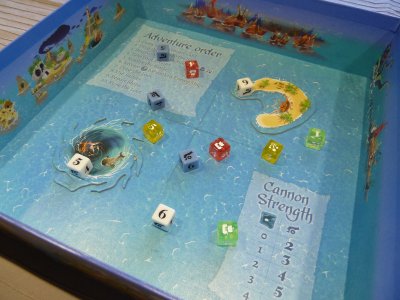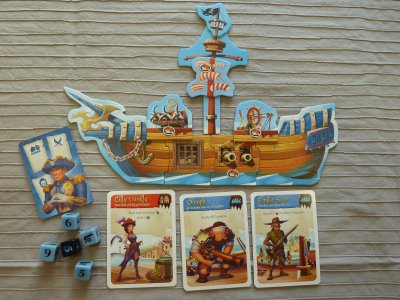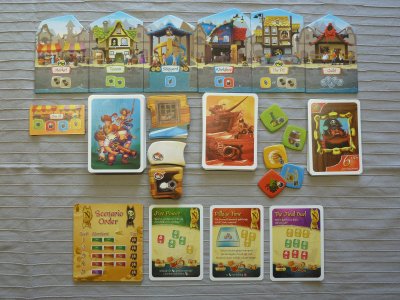

![[IMAGE]](../bilder/rbgrab1.jpg) |
Designer: Publisher: No. of Players: |
![[IMAGE]](../technik/box/rot/rot-5.gif) ![[IMAGE]](../technik/box/gelb/gelb-10.gif) ![[IMAGE]](../technik/box/grun/grun-6.gif) ![[IMAGE]](../technik/box/pink/pink-5.gif) ![[IMAGE]](../technik/box/blau/blau-8.gif) |
|
Dice. You can roll them to get randomized results, you can use them to mark life points or other varying stats, or you can even can toss them at each other in order to introduce some element of skill into a boardgame. Thousands of games use dice, and even though authors often try to find new, fresh ideas many games still use the classic combination of dice rolling and luck. However, this time Ignacy Trzewiczek from PORTAL has taken the helm for the design of a new dicegame, and I was quite sure that once again he would try to surprise the gaming world with one of his crazy combinations of strange ideas and wonderful playing mechanisms. The big box game Rattle, Battle, Grab the Loot certainly comes with an unusual title, and knowing that it was some kind of new dicegame I was eager to see what kinds of ideas Ignacy might have come up with…
The players take the roles of pirates, and over the course of the game they try to collect most victory points by successfully sinking and plundering enemy ships. During the game, the players' and enemy ships will be represented by dice, and the players will use their dice in a number of naval battles which together are part of a bigger scenario. Before such a battle begins, the players will reveal an adventure card which will list the number and colour of enemy ships (dice) participating in the upcoming battle, and in addition some special rules can be found on each card to set out the specifics of the individual adventure. To start the battle, one player then will gather up all player ships (dice) plus the enemy ships (dice), and in one combined move the player will drop all these dice into the bottom of the gamebox.
 This does not only sound strange, but if you now look into the bottom on the gamebox you will see a wild gathering of multi-coloured dice, some of them showing values whereas others might show certain symbols. Player dice are opaque and in the colour of each player, whereas the enemy dice are translucent, with the colours used to identify stronger and weaker dice. But how can this pile of dice be turned into a naval battle? Well, to solve the situation in the box, Ignacy has found a quite unique action sequence which allows the players to fight and plunder, and apart from the dices' results even some faint elements of tabletop gaming will be used. So, as a first step after the dicedrop, the players need to check whether any of the enemy ships/dice show symbols instead of numbers. If such a dice shows a ship symbol, the adventure card will tell the players how these ships will react. So, they might flee from the battle (dice is removed), they might move away or towards player dice, or they might even fire a volley. Movement and firing ranges are determined by using the long or short sides of the playing cards, and in addition the game also includes a cardboard range ruler which can be used to identify distances. When a ship fires a volley, it will chose the closest player dice as a target, and that dice also will be removed from the box. Once the actions triggered by the dice with symbols have been dealt with, it will be the players' opportunity to perform some actions, and in turn order they now have a possibility to move their dice within the box and to fire at enemy ships in range. For movement and firing the players need sails and cannons, and these can be acquired during port visits which will happen after one or more adventures (as set out on the scenario card chosen for the game). In a port the players can acquire improvements which will all be added to the player's flagship layout which is placed in front of the players, and these improvements then can be used by all of the player's ships (dice) during the battles. However, many of the improvements are flipped over when they have been used, and they will only be refreshed during the next visit to the port. But more about port visits later.  Back to the battle, players are allowed to sink enemy ships in range if they have enough active cannons on their flagship, and the sunk dice can be claimed and cashed in for a coin after the battle is over. However, usually there will still be player and enemy ships in the box after the player actions, and so it will now come to individual ship battles. Starting with the dice closest to each other, the individual values of two opposing dice will be compared, and a dice with the stronger value will now defeat a dice with a lower value, resulting once again in its removal for the box. If player ships sink enemy ships in this fashion they once again can be collected and cashed in for a coin after the battle, but it pays off even more if the player was able to move his dice to touch the enemy dice during the action phase. In this case the player will not just sink the enemy ship, but he will also plunder it during a boarding action, allowing him to draw a piece of plunder after the battle is over. Depending on the number of dice used in the adventure, quite a mass of dice may be present in the box, but in most cases the distances can be made out by good eye measure. Nonetheless, there exists a quite useful mobile phone app which can be used for finding out the closest pairs, and so no real discussions should arise on the question in which sequence the individual battles will be solved. Quite more interesting is the fact that a complex situation within the gamebox may trigger some unexpected results, and so the players need to develop an eye for the situation at hand in order to make good decisions where they should move their ships. Especially during the first games experienced players should point out these sequences before the players take their actions, because otherwise an unexperienced player may get frustrated by the chain of events. When all ship battles have been solved, the players will receive coins and pieces of plunder resulting from sinking and boarding ships and from participating in the scenario, and the plunder first must be used to repair all of their ships which have been destroyed during the battle. Remaining plunder is distributed among a player's ships and his flagship, waiting to be sold/used during the next port visit.  When the time for a port visit has come, all players are allowed to visit a number of locations typical for a pirate hideout, and at these locations they may use specific items of plunder to gain certain benefits. So, they may use rum to hire new sailors (coming from a random deck of characters), they may use fabrics and spices to buy improvements for the flagship, they may sell valuables to the Pirate King, and they may use their money to purchase special victory point cards (showing all kinds of piratish desires like a golden peg-leg or a Kraken pet). Wehen everybody has finished dealing with the locations, a new scenario will be drawn and the players will get ready for another ship-drop into the bottom of the box. The game includes 44 unique adventure cards, and quite a lot of creativity has been used to give each of these adventures a more or less unique feel. So, cardboard islands, a maelstrom or a sea monster may be added to the gamebox before the dicedrop, causing a special result to all dice touching them. Other special effects may be triggered by individual dice used for representing storms etc, and once again the players will have to face some quite interesting consequences. Taken together with the fact that the general scenario prescribes whether an easy, medium or hard adventure card will be drawn, all this makes the naval battles occurring during the game rather versatile, thus ensuring an entertaining playing experience all over the game's length. Indeed, the playing mechanism employed in Rattle, Battle, Grab the Loot is as unusual as the game's name, and when first looking and the nicely illustrated gamebox with the cute characters and gameparts you might be tempted to suspect a typical family game. While Rattle, Battle, Grab the Loot certainly is a comparatively light game which fits the class of family games almost perfectly, the game's structure explained above should make clear that the game is far away from being a typical dice roller. Ignacy has chosen to bring together elements of dice rolling, resource trading, improved actions and a tiny bit of tactical tabletop gaming, and the result is as unique as the combination of these mechanisms sounds. What is more important, Rattle, Battle, Grab the Loot works astonishingly well once the players get a grasp for interpreting the situation found in each naval battle, and on a sidenote it should also be mentioned that even a full cast of 5 players does not overcomplicate the game since the number of ships/dice available to each player will be reduced. To reduce the entry barrier even further the game contains a beginner's scenario, and on the other hand some advanced sailors and treasure loot tokens are included to give old sea dogs a special challenge. With all these elements coming together, Rattle, Battle, Grab the Loot certainly qualifies as one of the most remarkable games released in 2015! | ||
|
| ||

|
|

|
|
| ||
|
Impressum / Contact Info / Disclaimer Kulkmann@aol.com
Copyright & copy; 2015 Frank Schulte-Kulkmann, Essen, Germany | ||